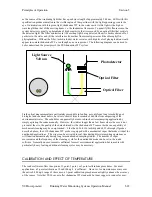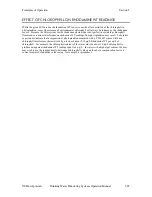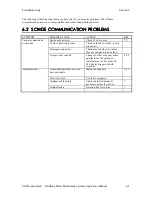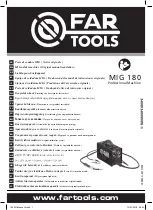
Principles of Operation
Section 5
YSI Incorporated Drinking Water Monitoring Systems Operation Manual
5-14
outgassing of the water. These bubbles can generally be removed in short term sampling application by
simply agitating the sonde manually. However, for studies longer than a few hours where the user is not
present at the site, the quality of the turbidity data obtained with a turbidity sensor that has no capability of
mechanical cleaning is likely to be poor. However, as noted above, both the 6136 probe is equipped with a
mechanical wiper that makes them ideal for unattended applications. The wiper can be activated in real-
time during discrete sampling operations or will function automatically during long term unattended
sampling studies. The number of wiper movements and the frequency of the cleaning cycle for the
unattended mode can be set in the sonde software. Generally one movement is sufficient for most
environmental applications, but in media with particularly heavy fouling, additional cleaning cycles may be
necessary.
CALIBRATION AND EFFECT OF TEMPERATURE
The sonde software offers the option of 1-point, 2-point, or 3-point calibrations procedures. For most
applications, a 2-point calibration at 0 and approximately 100 NTU is sufficient for the 6136 sensor to meet
the quoted accuracy specification of +/- 2% of the reading or 0.3 NTU, whichever is greater. (Note that the
specification is relative to measurements in calibration standards.) However, a user might wish to carry
out a 3-point calibration at values of approximately 0, 100 and 1000 NTU to provide maximum accuracy
over the entire normally encountered environmental turbidity range (0-1000 NTU).
If the range of
turbidity in the environmental sample is well known, standards of other turbidity values can be utilized (in
either 3 point or 2 point routines). However, in all calibration procedures, one of the standards must be 0
NTU and this should be the first calibration point.
NOTE:
Before calibrating your 6136 turbidity sensor, pay particular attention to the following caution:
•
For all calibration procedures, you MUST use standards that are based on either formazin or AMCO-
AEPA styrene divinylbenzene beads as described in
Standard Methods for the Examination of Water
and Wastewater
and have been prepared either by Hach (formazin based) or AMCO-AEPA based
standards prepared by YSI or an approved YSI vendor listed on the YSI website (www.ysi.com). THE
USE OF STANDARDS FROM OTHER VENDORS AND/OR THOSE PREPARDED FROM
MATERIALS OTHER THAN FORMAZIN OR AMCO-AEPA POLYMER BEADS WILL RESULT
IN BOTH CALIBRATION ERRORS AND INACCURATE FIELD READINGS
.
YSI and its approved vendors offer easy-to use AMCO-AEPA turbidity standards which can also be
quantitatively diluted with turbidity-free water to provide calibrant suspensions of lower values. Hach also
offers relatively inexpensive formazin suspensions at various NTU values up to 1000 NTU under the
Stablcal
TM
designation which will provide accurate calibration of either the 6026 or 6136 sensors as long as
the user is willing to exercise the proper safety precautions as outlined in the MSDS associated with formazin.
The primary advantage of the Hach formazin standards is their cost; their primary disadvantage is that the
suspended matter settles out fairly rapidly. Although the AMCO-AEPA standards are somewhat more
expensive, they do not settle out, making them significantly easier to use.
While the effect of temperature on the turbidity sensor is small, this factor is automatically taken into
account by the sonde software providing temperature compensated readings. Temperature coefficients of
0.3%/degree C and 0.6%/degree C are automatically activated for the 6026 and 6136, respectively, when
these sensors are activated in the
Sensor
menu.
MEASUREMENT AND CALIBRATION PRECAUTIONS
(1) For best results, use only freshly prepared or purchased turbidity standards. Degradation of standards
can occur on standing, particularly formazin prepared from dilution of concentrated suspensions such as
Hach 4000 NTU standard.
Содержание 600DW-B
Страница 3: ......
Страница 239: ...Principles of Operation Section 5 YSI Incorporated Drinking Water Monitoring Systems Operation Manual 5 26...
Страница 251: ...Warranty and Service Information Section 8 YSI Incorporated Drinking Water Monitoring Systems Operations Manual 8 4...
Страница 259: ...Required Notice Appendix B YSI Incorporated Drinking Water Monitoring Systems Operations Manual B 2...
Страница 264: ...EMC Performance Appendix D YSI Incorporated Drinking Water Monitoring Systems Operations Manual D 2...
Страница 268: ...Specifications Appendix E YSI Incorporated Drinking Water Monitoring Systems Operations Manual E 4...
Страница 297: ......
















































